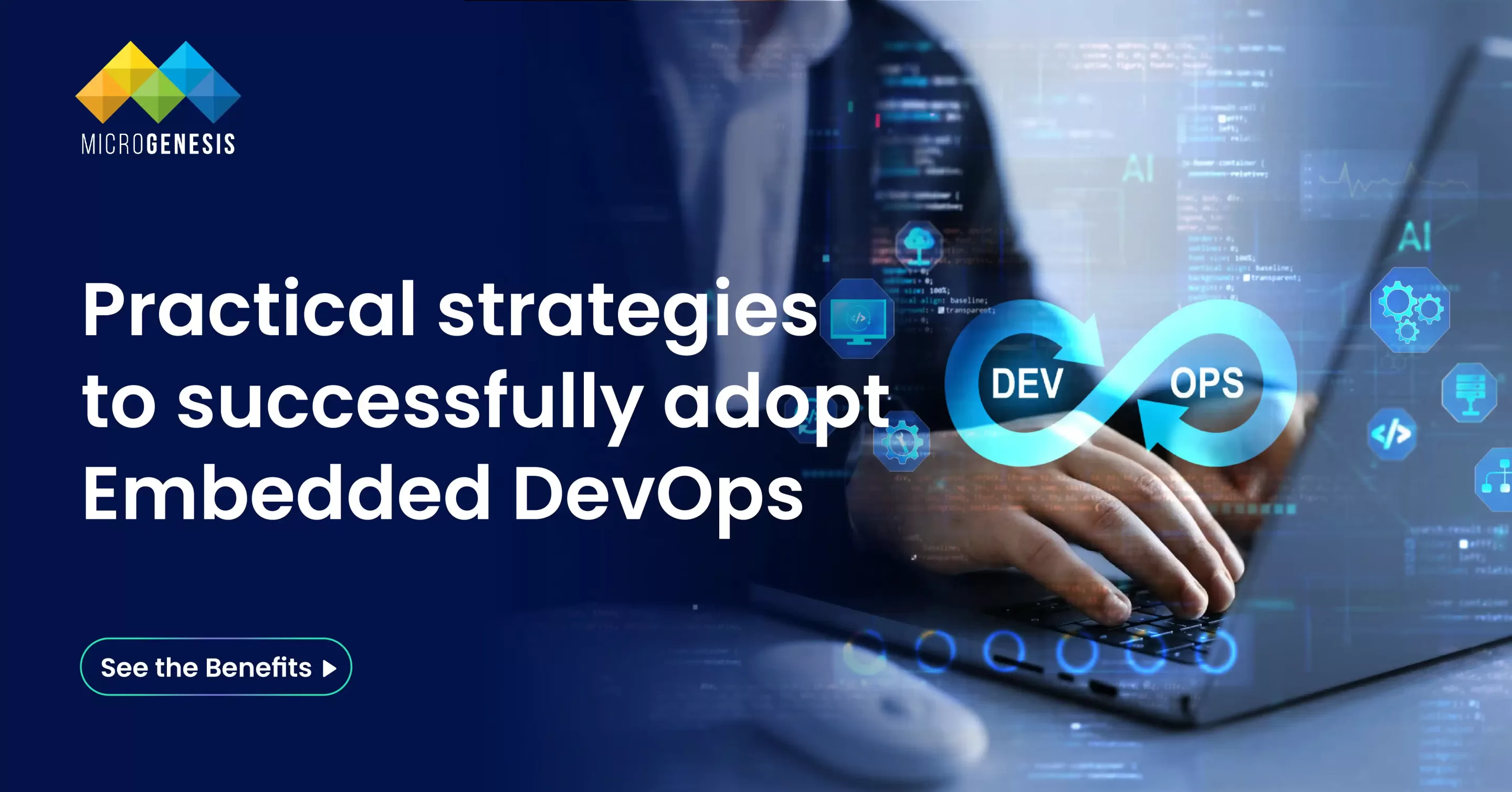The adoption of DevOps has transformed software delivery in web, enterprise, and mobile applications, enabling faster releases, better quality, and more efficient collaboration. But for embedded systems—software running on dedicated hardware—implementing DevOps isn’t a simple “copy-paste” exercise.
Embedded projects involve unique challenges:
- Tight hardware constraints.
- Complex hardware-software integration.
- Limited availability of test devices.
- Strict safety and compliance requirements.
- Risky deployments, where failed updates can brick devices.
Despite these challenges, Embedded DevOps—applying DevOps principles to firmware and embedded software—has the potential to dramatically improve development speed, quality, and maintainability. The key to success lies in adapting DevOps best practices to the realities of embedded systems.
In this article, we’ll walk through practical, proven best practices for implementing Embedded DevOps successfully.
2. Start with a Clear Strategy and Pilot Project
Jumping straight into a full-scale Embedded DevOps rollout is risky. Instead:
- Define clear goals: Faster release cycles, improved quality, reduced defects, better compliance—know what you’re aiming for.
- Select a pilot project: Choose a project that’s important but not mission-critical for the first implementation.
- Measure success: Track metrics like build time, defect rates, and time-to-release before and after the pilot.
Tip: Pick a project with good OS and hardware simulation support to make automation easier in the early stages.
3. Integrate Hardware and Software Workflows
One of the biggest barriers to Embedded DevOps is the hardware/software divide.
- Use shared version control (e.g., Git, Perforce) for firmware, hardware design files, and documentation.
- Align release cycles between hardware and firmware teams so integration happens earlier.
- Introduce cross-functional teams where hardware, firmware, QA, and DevOps engineers work together from day one.
Example: A robotics company moved PCB schematics, firmware, and simulation models into the same Git repository. This allowed the firmware team to adapt quickly when the hardware team made sensor changes, reducing integration delays by 40%.
4. Automate Builds Early and Often
Automation is the backbone of any DevOps practice:
- Set up a Continuous Integration (CI) pipeline to compile firmware on every commit.
- Include static analysis (MISRA checks, linting) in the build to catch issues early.
- Generate firmware binaries automatically and store them in an artifact repository (e.g., JFrog Artifactory, Nexus).
Key Consideration: Embedded builds often require cross-compilers and target-specific toolchains—containerize these environments (using Docker or Podman) to ensure consistency across developer machines and CI servers.
5. Combine Simulation and Hardware-in-the-Loop Testing
You can’t scale Embedded DevOps without balancing simulation and real hardware testing:
- Simulation/Emulation: Use QEMU, Renode, or vendor-specific simulators for fast, early-stage testing.
- Hardware-in-the-Loop (HIL): Integrate real boards into automated test rigs for integration and performance validation.
- Test Prioritization: Run quick simulation-based smoke tests on every commit, then run extended HIL tests overnight or in staging.
Best Practice: Create a device farm with remote access, so CI pipelines can deploy firmware and run tests on actual hardware automatically.
6. Implement Robust Over-the-Air (OTA) Update Mechanisms
OTA updates are a cornerstone of modern embedded product maintenance:
- Use secure bootloaders that verify firmware signatures before installation.
- Implement rollback functionality in case of failed updates.
- Support staged rollouts to minimize the risk of widespread device failures.
- Monitor update success/failure rates to quickly detect issues.
Security Tip: Always sign firmware images with a private key and verify signatures with a corresponding public key stored securely in the device.
7. Build Security into Every Stage
Security can’t be bolted on at the end—it must be integrated from the start:
- Include static application security testing (SAST) and dependency scanning in CI.
- Use threat modeling during design to identify potential vulnerabilities early.
- Rotate encryption keys periodically and avoid hardcoded credentials.
- Monitor deployed devices for unusual behavior indicating a security breach.
Example: An IoT camera vendor integrated automated CVE scanning into their build pipeline, allowing them to patch vulnerable third-party libraries within days instead of months.
8. Treat Test Hardware as Infrastructure-as-Code (IaC)
In cloud DevOps, IaC is used to manage servers. In Embedded DevOps, the concept extends to test infrastructure:
- Define hardware configurations (board type, peripherals, firmware version) in code or config files.
- Automate hardware provisioning—flashing firmware, setting up power, connecting test equipment—through scripts.
- Keep hardware setups reproducible so other teams can mirror them.
Benefit: New team members or CI servers can replicate test setups exactly, reducing “it works on my bench” issues.
9. Enforce Compliance Through Automation
If you’re in a regulated industry (medical, automotive, aerospace), compliance isn’t optional:
- Integrate requirements management tools with version control and CI to automatically link requirements to code changes and tests.
- Generate compliance evidence (test results, traceability reports) automatically from the pipeline.
- Implement pipeline gates that block deployments if required compliance steps are missing.
Example: An automotive ECU developer automated ISO 26262 compliance evidence generation, cutting audit preparation time from 3 months to 3 weeks.
Read More: How to Create a DevOps Workflow: Phases and Best Practices
10. Monitor and Analyze Field Data
One of the strengths of Embedded DevOps is its ability to close the feedback loop:
- Collect telemetry from deployed devices (performance metrics, error logs).
- Use this data to prioritize bug fixes and feature improvements.
- Integrate monitoring alerts with development workflows so issues detected in the field automatically create tickets.
Best Practice: Implement lightweight, secure telemetry protocols (e.g., MQTT, CoAP) to avoid overloading devices or networks.
11. Foster a DevOps Culture
Tools and pipelines are useless without the right mindset:
- Promote shared ownership of product quality and delivery timelines.
- Encourage frequent communication between hardware, firmware, QA, and operations teams.
- Reward teams for preventing defects early, not just for delivering features.
Cultural Tip: Regularly demo pipeline improvements to the whole organization—showing reduced build times or automated compliance checks helps win buy-in.
12. Measure, Optimize, Repeat
DevOps isn’t a one-time setup—it’s a continuous improvement process:
- Track metrics like build duration, test pass rates, defect escape rates, and deployment success rates.
- Identify bottlenecks—long build times, limited hardware availability, slow manual processes—and prioritize fixes.
- Experiment with process changes in small steps, measuring impact before wide adoption.
Example: A consumer electronics company reduced firmware build time from 45 minutes to 8 minutes by switching to distributed build systems and caching dependencies.
13. Common Pitfalls to Avoid
Even with best practices, Embedded DevOps projects can fail if:
- Hardware bottlenecks aren’t addressed (too few test devices).
- Security is an afterthought.
- Teams focus only on automation, ignoring cultural change.
- Compliance requirements are overlooked until late in the project.
- OTA update systems lack rollback mechanisms.
14. Conclusion
Implementing Embedded DevOps is about more than copying software DevOps pipelines into a hardware context—it requires careful adaptation to handle the realities of hardware integration, constrained environments, and high-stakes deployments. With the right DevOps consulting services, organizations can tailor practices to embedded needs, reduce risks, and accelerate product delivery.
By:
- Starting with a small pilot,
- Integrating hardware and software workflows,
- Automating builds and tests,
- Building security and compliance into the pipeline, and
- Maintaining a culture of continuous improvement,
Organizations can achieve faster release cycles, better quality, improved security, and greater operational efficiency in their embedded systems projects.
Embedded DevOps isn’t easy—but for companies building connected, intelligent devices, it’s quickly becoming a competitive necessity. Partnering with a trusted digital transformation consultant like MicroGenesis ensures the right strategies, tools, and practices are in place to maximize the impact of Embedded DevOps.




